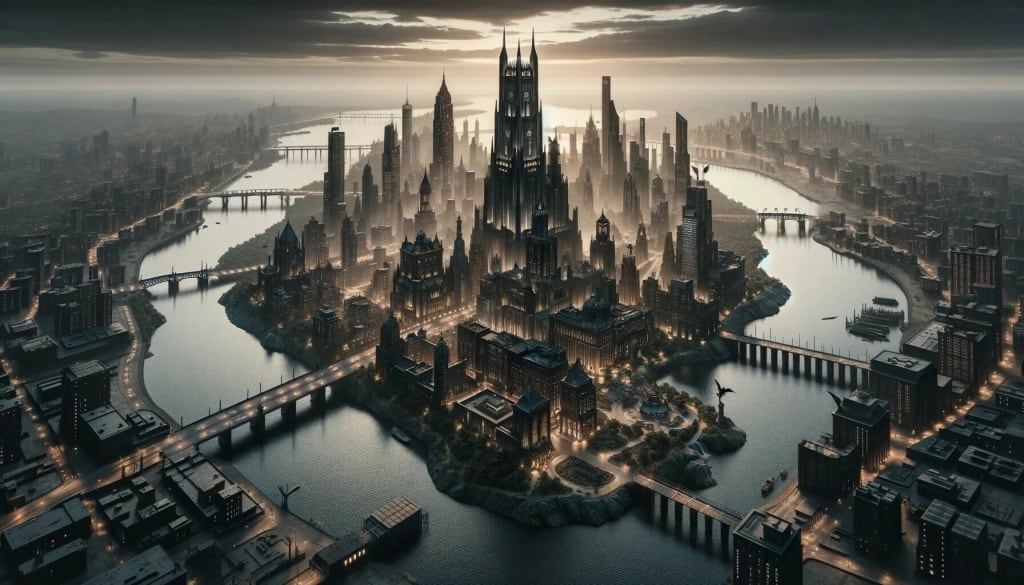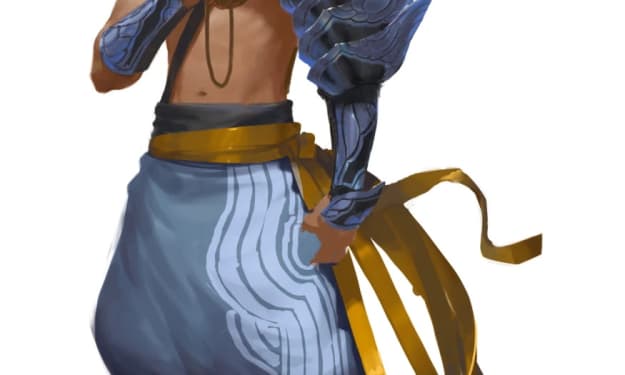The Real Fiction City: The Origin of Gotham City
Batman's City

The Location and Urban Design of Gotham City
Gotham City was named by Batman writer Bill Finger. When asked how he chose the name "Gotham" and why he didn't just use New York City, Finger said:
I originally planned to refer to Gotham City as a 'citizen city'. Then I tried the 'capital' and then the 'coastal city'. Then I flipped through the phone book of New York City and found the name "Gotham Jewelers", and said, "That's it, Gotham City.". We didn't call it New York because we wanted anyone in any city to identify with it
According to the original author, Gotham can be any city. Therefore, some people say Gotham is New York under the darkness, while others say Gotham is Chicago during the era of gangsters... In fact, in 1977 and 1990 DC comics, Gotham's position was pointed to New Jersey.
In the 1990s, artist and illustrator Eliot R. Brown, who grew up in New York, designed the first draft of a city map for Gotham City. Brown has not received formal training in cartography, but he has studied architecture and has worked as a technical artist at Marvel Comics. Due to the fact that Gotham City was completely destroyed by an earthquake in the 1998 No Man's Land storyline, the specific prototype of Gotham City was officially put on the agenda.
Elliott R. Brown's Early Design Manuscripts
From the initial design draft, it can be seen that Gotham's idea was still inspired by Manhattan, a peninsula surrounded by rivers on both sides, a park in the center of the city, and a bridge connecting the land on both sides... All of this was not only due to Brown's familiarity with New York, but also the result of discussions with DC Comics editors:
"DC Comics' editors have made it clear that Gotham City is an idealized version of Manhattan. Like most comic book structures, it must do a lot of things. It needs a refined and dark side. The commercial and exquisite residential areas. Entertainment, meat packaging, clothing, docks and their docks business. In short, the entire Manhattan and Brooklyn are packed with... well, a good page layout."
Brown's final draft positioned Gotham City in the Greater Bay Area of New Jersey, and in reality, Gotham City's location is a sea. The entire city is divided into three urban areas by two rivers, upper, middle, and lower. This map of Gotham City includes many bridges and tunnels that are ready to be bombed by the US government, as well as some forgotten steam tunnels that may be useful for criminals and their allies. After the Batman: The Unmanned Zone comic storyline ended in 1999, this map became a classic of the DC universe, and the subsequent team continuously developed and improved it, appearing multiple times in Batman movies.
Elliott R. Brown's Completed Draft
The map of Gotham City appears in the promotional materials of Christopher Nolan's Dark Knight Rise (2012)
The founder and initial designer of Gotham City
Although Gotham City is fictional, it has many shadows from the establishment of major American cities. The Batman comic Gates of Gotham, published in 2011, tells the story of how Gotham City was established. The history of Gotham during the colonial period can only be summarized in one short sentence:
Norwegian mercenary Captain Jon Logquist established Gotham City in 1635, which was later taken over by the British - a story similar to the Dutch establishing New York (as New Amsterdam) and later being taken over by the British.
As early as 1840, Solomon Wayne (father of railway tycoon Alan Wayne) commissioned architect Cyrus Pinkney to design a series of buildings, which became the beginning of Gotham's industrial and commercial agglomeration. This Solomon Wayne is also Bruce Wayne's great great great grandfather and the original founder of Gotham City.
The reason why Solomon Wayne chose Gotham for development in the 19th century was simple, as Gotham's geographical conditions were similar to the thriving New York and Boston of the same era, with one side being the mouth of an inland river and the other side being the Atlantic Ocean.
He firmly believes that as long as time passes, this city will inevitably become a new industrial center. Facing this land, Solomon Wayne expressed his ideal manifesto:
What is a city, gentlemen? A holy land! A stronghold! Fortress! The fortress against atheism in the wilderness - where we can cultivate the talent of Christian civilization - and be free from all the savage invasion lurking in the savage nature.
This vision can be traced back to Hugh Ferriss's book "The Metropolis of Tomorrow" in the real world:
Occasionally in the morning, when the morning mist has not yet dissipated, people will find themselves stepping on the railing, becoming onlookers in a more blurred panoramic view. Literally, you can't see anything except for fog; Apart from the adjacent railing, there is not a tower below yet There is no indication of locality or reliability for the upcoming scene. For an imaginative audience, it seems like they are sitting in a high stage box, witnessing some kind of huge spectacle, some form of spectacular drama; And that scene has not yet risen At least for a moment of surprise. What Revelation is about to be revealed? What is its setting? What is the main theme of this modern urban drama?
By 1920, Ferris began to develop his own style, often showcasing the building at night, illuminated by spotlights, or in fog, as if shooting with a soft focus. The shadows cast by buildings are almost as important as the exposed surfaces. The high-rise buildings in "Tomorrow's Metropolis" are deeply influenced by zoning laws and are shrouded in dazzling light in the dark.
Left: Boston Avenue Methodist Church; Middle and Right: Sketch of Wayne Center
Influenced by the religious fervor in Cyrus Pinkney's designs, Solomon Wayne funded his design of many iconic buildings in Gotham City, such as Gotham Cathedral, Solomon Wayne Court, and Gotham Commercial Bank. Later, Pinkney met a young medical student named Amadeus Akam. Amadeus's wisdom, kindness, and visionary plan to reform criminals left a deep impression on him, and Pinkney helped him design the famous Arkham Asylum in Batman comics.
The Danfoss State Mental Hospital, believed to be the prototype of the Arkham Mental Hospital, was established in 1874 and began to decline in the 1960s. It was eventually completely abandoned and demolished in the 1990s.
Although most people believe that Pinkney's architectural style is dark, dull, and bizarre, Solomon believes that towering buildings and stone figures can dispel the malice in people's hearts. This setting may be a metaphor for Batman's resemblance to a towering stone figure on a tower. The towering and dense skyline of Gotham City resembles ghostly figures in the rendering of night and industrial smoke, giving off a strong impression of Gothic architecture. In the manga, Cyrus Pinkney died young at the age of only 40, while Solomon Wayne, as a sponsor, lived to the age of 104. Before his death, Solomon Wayne sighed, "I hope to turn evil away, but I am worried that I have given it (Gotham) the means to be locked in by evil."
Design draft for Gotham City in the 1989 Batman movie
The architectural style designed by Cyrus Pinkney is known as the Gotham Style by the world. In reality, it was written by Anton Furst and Nigel Phelps. The classic scenes in the film are all based on their designs, such as the Gotham Police Headquarters, Wayne Building, and so on.
The founding family of Gotham City and the brother architects known as the "Gate of Gotham"
In the DC setting, there are a total of five families considered as the main founders of Gotham, namely: Wayne, Kanes, Elliots, Crownes, and Cobblepot. In the late 19th century, the initial eastern half of Gotham was owned by railway tycoon Alan Wayne, while the northern half of Gotham was owned by Cameron Kane. Steel and construction tycoon Theodore Copperport served as the mayor of Gotham City in the 1880s. The owner of Gotham Herald is newspaper tycoon Edward Elliott. Except for the rarely mentioned Crons family, the original construction of Gotham was entirely based on the ideas of the four founding family chiefs after the death of Solomon Wayne. They hired architect Nicholas Anders [12] and his stepbrother Bradley Gates [13] to design several bridges connecting Gotham to the outside world. Except for the original Trigate Bridge, the remaining two bridges were named after sponsors, including the then mayor Theodore Copperport and newspaper tycoon Edward Elliott. Shortly after the bridge was built, the two were invited to build the Old Wayne Tower. With the completion of these projects, the brother's reputation grew, and Nicholas decided to take his brother's surname, Gates. Both are collectively referred to as the "Gate of Gotham".
In 1892, Cameron Kane, an industrial tycoon from Gotham City, participated in the bridge construction project. He worked hard to promote a new bridge connecting Gotham and the northern counties owned by Kane. At this time, Mayor Theodore was worried that this connection would worsen Gotham's security and jeopardize his re-election. The two families, except for the Wayne family, held opposite opinions, so these founding families gave the decision-making power to Nicholas. Nicholas, out of admiration for Alan Wayne and his early personal friendship, decided to connect this new bridge to the eastern region owned by Alan Wayne, which also angered Cameron Kane.
Unfortunately, it followed and ultimately completely destroyed the careers and lives of the two brothers. A major accident occurred during the construction of the new bridge. Bradley was wearing underwater protective clothing while working on the foundation of the bridge below the waterline, but the bridge suddenly collapsed and hit him. Nicholas finally found Bradley's helmet only in the wreckage. Afterwards, Nicholas lost the design and management rights of the bridge, and the new bridge was re planned as the initial location connecting Gotham and Northern County, as Cameron Kane had clearly expressed his full support for Mayor Theodore's re-election.
Nicholas suspected that this was revenge from the Kane and Elliot families and approached Alan Wayne, hoping that the latter could help him clear his grievances and avenge his brother, but this time he was refused. Alan Wayne did not intend to argue with the other two families for family interests without evidence. This made Nicholas realize the essence of the corruption of the upper class family, and as revenge, he killed Robert Kane (son of Cameron Kane), causing him to go crazy and be sent to Arkham Mental Hospital.
The Destroyers and Architectural Critics of Gotham City
In addition to the storyline of Gotham's Gate, another architectural related storyline is undoubtedly Batman: The Destroyer, published in 1992. The antagonist in this story is an architecture enthusiast named Andre Sinclair, who claims to be a descendant of architect Nicholas Anders and is obsessed with the Gotham style of Cyrus Pinkney. He firmly believes that modern architecture has destroyed all virtues in the city and alienated urban residents:
"Live in a box, shop in a box, die in a box. Robots, that's what they want. Not humans. Consumer robots. Straight lines sharp angles square boxes. No wonder this city is crazy."
This declaration is almost a precise attack on modern architecture, and therefore the crime of the villainous destroyer is to blow up specific modern buildings to reveal the Gothic style architecture originally designed by Cyrus Pinkney. This may be the only villain who appears for the sake of architectural dreams. (Speaking of the previous artist's villain, I only remember Didara in the Hokage)
The ending of this villain who attempted to retro is also very sad. He was ultimately eliminated as a terrorist, and his dying declaration did not forget to give up his dream:
"Man is such a fleeting thing. He lives, he commits a crime, he dies. But a city can stand for a thousand years. Dreams can last forever."
Ironically, the towering towers that Cyrus Pinkney once had high hopes for did not inspire awe, and the straight roads and overpasses did not lead city residents on the path of justice and nobility, let alone the curved shapes that tried to confuse evil forces and the stone statues that guarded the city. Buildings have failed to create the necessary moral environment for urban residents, and the shadows cast by towering towers have become a breeding ground for crime, isolating the possibility of communication between the upper and lower levels of society. As an atheist, Batman became Gotham's redemption and faith years later with his violent and decisive behavior. But the stone statue ghost living at the top of the tower can never understand the corruption under the shadow.
Is it Gotham who led the crime or is it evil that corrupted Gotham? It seems that the architect's wishful thinking has failed in this real fictional city.
Perhaps it is appropriate to end with another sentence from Hugh Ferriss:
"The contemplation of the entire metropolis ultimately makes us realize that humans unconsciously respond to forms that arise without conscious design. However, hope may begin to define itself in our minds. Perhaps it has not yet emerged, or perhaps in another generation, architects will unconsciously appreciate the influence and consciously learn to guide it?"
About the Creator
Peter Uri
Shared Knowledge and Experience
Enjoyed the story? Support the Creator.
Subscribe for free to receive all their stories in your feed. You could also pledge your support or give them a one-off tip, letting them know you appreciate their work.






Comments
There are no comments for this story
Be the first to respond and start the conversation.